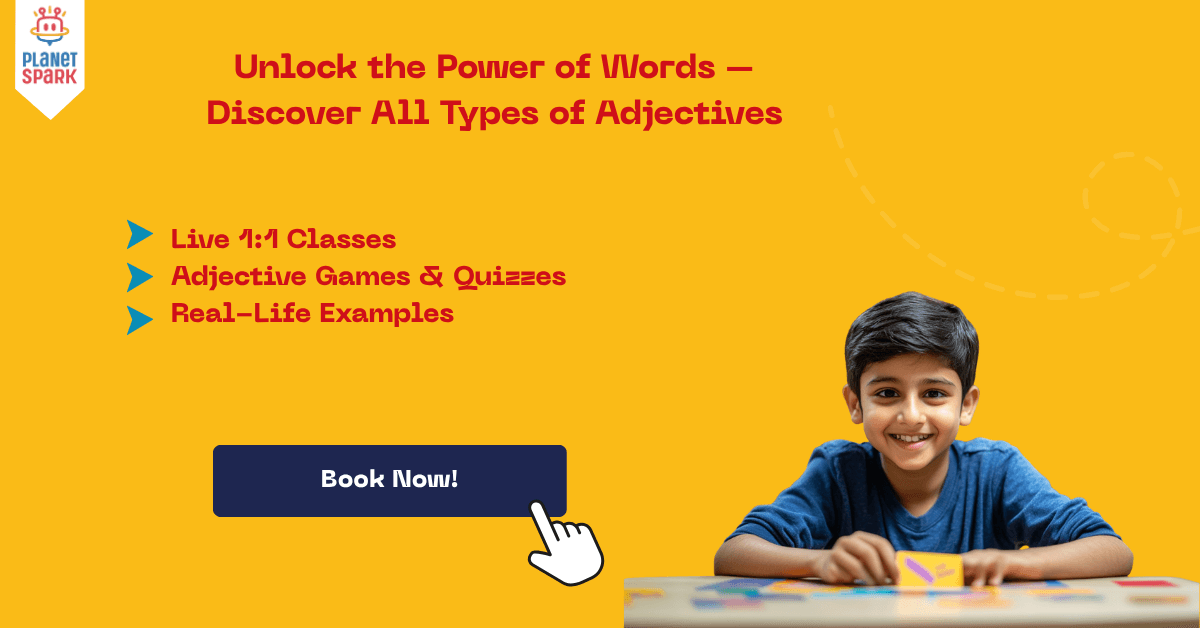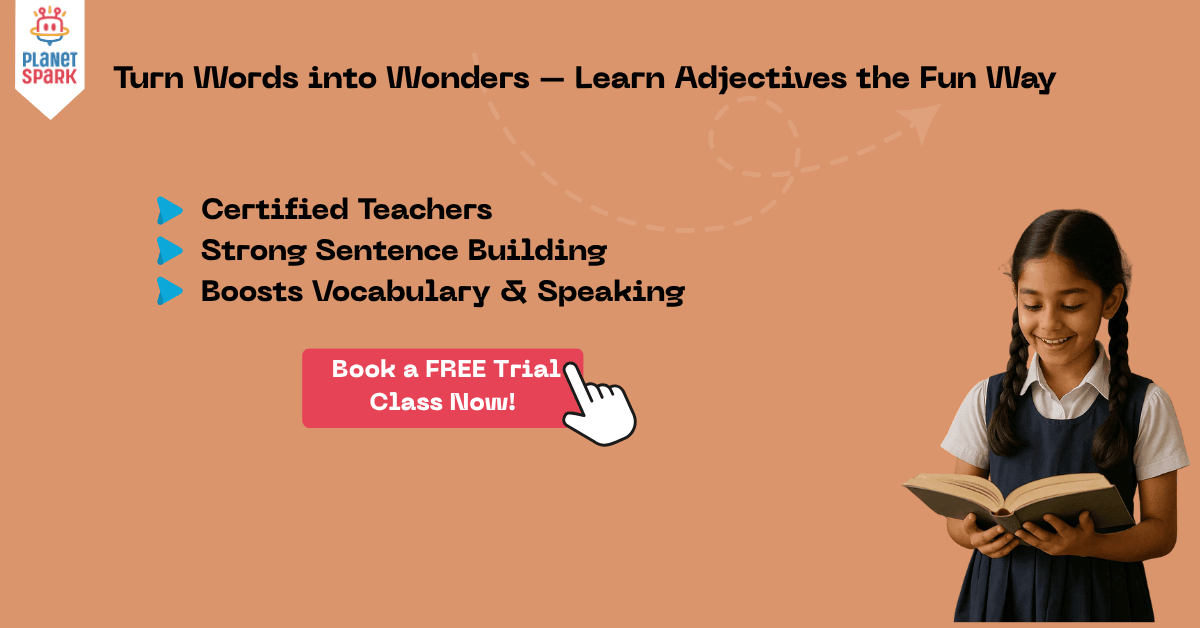Types of Adjectives: Definitions, Examples & Full Guide

Table of Contents
- What Are Adjectives?
- Why Learn the Different Types of Adjectives?
- 5 Types of Adjectives with Examples
- How to Teach Types of Adjectives to Kids?
- Adjective Exercise Ideas
- Real-World Application of Adjectives
- PlanetSpark’s English Grammar Program: Build Real-World Flue
- Conclusion
- FAQs:
- 1. What are the main types of adjectives in English grammar?
Adjectives are powerful words that help us describe, compare, and express feelings about people, places, and things. Without adjectives, language would be dull and expressionless. If you've ever wondered how to explain something in more detail, you're already reaching for an adjective.
In this detailed guide, we’ll cover the types of adjectives, and how they function, and provide clear, relatable examples to make grammar easier for kids, students, and learners of all ages.
What Are Adjectives?
An adjective is a word that describes a noun or pronoun. It gives us more information about a person, place, or thing.
Examples:
The tall building
A beautiful dress
An angry customer
In each case, the adjective adds flavor to the sentence, helping the reader understand something about the noun.
Why Learn the Different Types of Adjectives?
Understanding the different types of adjectives allows learners to speak and write with clarity and impact. It helps build:
Descriptive vocabulary
Fluent sentence structure
Effective communication in speaking and writing
With the right adjectives, even simple sentences become vivid and expressive.
1. Descriptive Adjectives
Descriptive adjectives are the most common type. They describe the quality or state of a noun.
Examples:
A soft pillow
The blue sky
A loud noise
These adjectives tell us “what kind” of noun we’re dealing with.
2. Quantitative Adjectives
Quantitative adjectives describe how much or how many of something there is.
Examples:
I have three pencils.
There is enough water.
She wants some coffee.
They help specify quantity, making your language more precise.
3. Demonstrative Adjectives
These adjectives point to specific things.
Examples:
This book is mine.
That girl is my sister.
Those apples are ripe.
They work closely with nouns and make your writing specific and clear.
4. Possessive Adjectives
Possessive adjectives show ownership or relation.
Examples:
My bag is missing.
Her shoes are under the bed.
Their house is huge.
These adjectives help indicate to whom something belongs to.
5. Interrogative Adjectives
Used in questions, these adjectives help gather information.
Examples:
Which book is yours?
What time is it?
Whose pen is this?
They are used when the adjective is part of a question related to a noun.

6. Indefinite Adjectives
These adjectives do not point to a specific noun but refer to non-specific quantities or objects.
Examples:
Many people were waiting.
Several students left early.
Few options are available.
These are helpful when you’re being general or approximate.
7. Proper Adjectives
Proper adjectives come from proper nouns and always begin with a capital letter.
Examples:
Indian cuisine is spicy.
Shakespearean drama is complex.
French pastries are delicious.
These adjectives give cultural or national context.
8. Articles as Adjectives
Articles like a, an, and the function as adjectives because they modify nouns.
Examples:
I saw a cat.
She bought an umbrella.
The movie was amazing.
Though they’re small, they play a big role in sentence clarity.
9. Comparative Adjectives
These adjectives compare two nouns.
Examples:
She is taller than him.
This movie is better than the last one.
My car is faster than yours.
They usually end in -er or are combined with more.
10. Superlative Adjectives
Used to compare more than two nouns, superlatives indicate the highest or lowest degree.
Examples:
He is the tallest in the class.
This is the best cake I’ve tasted.
That was the worst experience.
They often end in -est or are preceded by most/least.
5 Types of Adjectives with Examples
Here’s a quick summary of the 5 types of adjectives with examples for revision:
| Type | Function | Example |
|---|---|---|
| Descriptive | Describes quality | A happy child |
| Quantitative | Indicates quantity | Two dogs barked |
| Demonstrative | Points to specific items | These cookies are fresh |
| Possessive | Shows ownership | His car is red |
| Interrogative | Forms questions | Which dress do you like? |
How to Teach Types of Adjectives to Kids?
Teaching the types of adjectives to kids should be fun and engaging. Here are a few techniques:
Use colorful flashcards with examples
Play adjective games like “Describe This.”
Encourage students to write adjective-rich sentences
Show visuals and ask them to describe using adjectives
Introduce grammar comics or storytelling
By using activities and context, kids retain the information better and enjoy learning.
Adjective Exercise Ideas
1. Identify the Adjective
Underline the adjective in the sentence.
The red balloon flew away.
I ate two sandwiches.
2. Fill in the Blank
She wore a ___ dress. (adjective of color)
I saw ___ animals in the zoo. (quantitative adjective)
3. Make Your Sentence
Ask kids to create a sentence using any possessive or comparative adjective.

Real-World Application of Adjectives
Here are the ways to use adjectives for kids:
- Communicating more expressively
- Writing descriptive stories and essays
- Feeling confident while communicating
- Performing better in exams and grammar tests
Knowledge of various categories of adjectives forms the basis of all school syllabi and is a must for competitive exams and interviews in the future.
PlanetSpark’s English Grammar Program: Build Real-World Fluency
PlanetSpark's English grammar course is structured not only to instruct rules but to help learners implement them automatically in actual communication. Here's how the program excels:
Interactive Grammar Learning – No Rote Learning
At PlanetSpark, grammar is not taught by monotonous rule memorization. Rather, learners absorb through stories, conversations, role-plays, and live error correction, making grammar significant and memorable.
Gamified Learning Tools
From grammar games to interactive quizzes, students participate in enjoyable exercises that make even tough grammar fun and easy to understand.
Integrated Writing Practice
Every grammar topic is followed by sentence construction and writing exercises. This way, students get to apply what they have learned right away, transforming rules into living skills.
Grammar Proficiency Levels
Students work their way through sequentially arranged levels - beginning with nouns, verbs, punctuation, and progressing up to higher-level grammar such as conditionals, the passive voice, and reported speech, all with obvious learning checkpoints.
Parent Reports on Grammar Skillsets
Parents are given comprehensive reports that indicate how their child is doing in:
- Writing fluency
- Sentence complexity and structure
- Grammatical accuracy
- Logical content structure and flow
- Critical thinking and imagination
- Confidence, modulation of voice, and delivery
Body Language and syntax
Conclusion
Adjectives are much more than descriptive words - they are the soul of expression in English. From telling us how something looks to how many things there are, they enrich our language and make communication vivid. Understanding the types of adjectives and examples helps students write stories, answer grammar questions, and communicate fluently. When taught in an engaging and contextual way, grammar becomes easy - even fun! So, whether you're revising the 5 types of adjectives with examples or exploring different types of adjectives in a story, you now have the tools to master them. And if you're looking for expert guidance, PlanetSpark’s live grammar programs are designed to make every learner feel confident, curious, and creative with English.
FAQs:
1. What are the main types of adjectives in English grammar?
Ans. The main types of adjectives include descriptive, quantitative, demonstrative, possessive, interrogative, and proper adjectives. Each type serves a different function to describe or modify nouns and pronouns in a sentence.
2. Why is it important to learn the different types of adjectives?
Ans. Learning the different types of adjectives helps improve sentence clarity, writing expression, and vocabulary. It also enhances reading comprehension and speaking fluency by allowing learners to describe things more effectively and creatively.
3. Can you give me the 5 types of adjectives with examples?
Ans. Certainly! Here are 5 types of adjectives with examples:
- Descriptive - A tall building
- Quantitative - Three cookies
- Demonstrative - That book
- Possessive - Her shoes
Interrogative - Which movie did you watch?
4. How do PlanetSpark’s classes help kids learn types of adjectives and examples?
Ans. PlanetSpark teaches grammar through interactive sessions, story-based learning, and gamified tools. Kids practice adjectives through writing tasks, roleplays, and quizzes, ensuring deep understanding and long-term retention.
5. What’s the difference between descriptive and demonstrative adjectives?
Ans. Descriptive adjectives tell us more about the quality of a noun (e.g., happy, blue, loud), while demonstrative adjectives point to specific nouns (e.g., this, that, these, those). Both serve different roles in adding clarity to communication.
6. Are there any fun ways to teach types of adjectives to children?
Ans. Yes! You can teach adjectives using flashcards, adjective scavenger hunts, adjective charades, or by asking children to describe their surroundings. PlanetSpark integrates such engaging activities to make learning fun and practical.
7. How can I know if my child is improving in grammar?
Ans. PlanetSpark provides detailed parent reports that track your child’s progress in areas like sentence structure, grammatical accuracy, writing fluency, and more. These insights help monitor improvement and set clear learning goals.
Personalized Communication Report
Record a video to get a AI generated personalized communication report for your child

Hi There, want to try these
tips for your child with
LIVE with our expert coach?
Let's check your child's
English fluency
